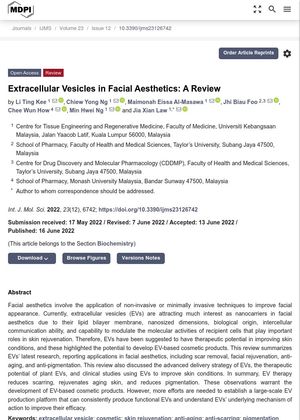Extracellular Vesicles in Facial Aesthetics: A Review
June 2022
in “International Journal of Molecular Sciences”

TLDR Tiny particles called extracellular vesicles show promise for skin improvement and anti-aging in facial care but face challenges like low production and lack of research.
The document "Extracellular Vesicles in Facial Aesthetics: A Review" discusses the potential of extracellular vesicles (EVs) in improving skin conditions and their application in facial aesthetics. EVs can inhibit the migration and proliferation of hypertrophic scar tissue-derived fibroblasts, reducing collagen deposition and attenuating fibrosis. They also enhance fibroblast activities, regulate collagen turnover, reduce ROS production, and reduce tissue inflammation, contributing to anti-aging effects. For anti-pigmentation, EV treatment can slow down UVB-stimulated melanin production and promote melanosome degradation. Various physical and chemical penetration enhancing technologies, such as microneedles, and incorporation with hydrogel and scaffold, have been explored to increase the absorption of EVs into the skin. EVs from various sources, including plants, have shown potential in promoting skin rejuvenation and regeneration, as well as anti-aging and anti-pigmentation effects. However, challenges such as low yield, inconvenient storage, short shelf-life, insufficient clinical data, and lack of understanding of the appropriate dosage and mechanism of action hinder the commercialization of EV-based cosmeceuticals. More research and improved guidelines are needed to promote the use of EVs in the facial aesthetics industry.
View this study on mdpi.com →
Cited in this study

research Extracellular Vesicles: Emerging Therapeutics in Cutaneous Lesions
Tiny particles called extracellular vesicles show promise for treating skin conditions and promoting hair growth.

research Recent Understandings of Biology, Prophylaxis and Treatment Strategies for Hypertrophic Scars and Keloids
The document concludes that the understanding of scar formation is incomplete and current prevention and treatment for hypertrophic scars and keloids are not fully effective.